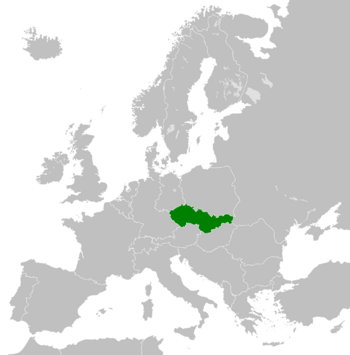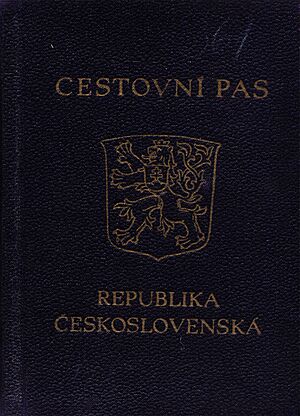Third Czechoslovak Republic facts for kids
Quick facts for kids
Czechoslovak Republic
Československá republika
|
|||||||||||||||||||
|---|---|---|---|---|---|---|---|---|---|---|---|---|---|---|---|---|---|---|---|
| 1945–1948 | |||||||||||||||||||
|
Motto: Pravda vítězí / Pravda víťazí
"Truth prevails" |
|||||||||||||||||||
|
Anthem:
Lightning Over the Tatras |
|||||||||||||||||||

Territory of the Third Czechoslovak Republic
|
|||||||||||||||||||
| Capital and largest city
|
Prague | ||||||||||||||||||
| Official languages | Czechoslovak (Czech and Slovak) | ||||||||||||||||||
| Government | Parliamentary republic | ||||||||||||||||||
| President | |||||||||||||||||||
|
• 1945–1948
|
Edvard Beneš | ||||||||||||||||||
| Prime Minister | |||||||||||||||||||
|
• 1945–1946
|
Zdeněk Fierlinger | ||||||||||||||||||
|
• 1946–1948
|
Klement Gottwald | ||||||||||||||||||
| Historical era | Cold War | ||||||||||||||||||
|
• Surrender of Nazi Germany
|
8 May 1945 | ||||||||||||||||||
| 24 October 1945 | |||||||||||||||||||
|
• Communist seizure of power
|
25 February 1948 | ||||||||||||||||||
| Currency | Czechoslovak koruna | ||||||||||||||||||
|
|||||||||||||||||||
| Today part of | |||||||||||||||||||
The Third Czechoslovak Republic was a country that existed from April 1945 to February 1948. It was officially called the Czechoslovak Republic. This period began right after World War II ended.
After Nazi Germany was defeated, Czechoslovakia was re-established with the same borders it had before the war. It was recognized again by other countries. However, the Communist Party of Czechoslovakia (KSČ) became very powerful. This meant Czechoslovakia was heavily influenced by the Soviet Union. The country's plans for rebuilding after the war were shaped by this influence. Key decisions were made by President Edvard Beneš and Communist Party members who had been living in Moscow.
In February 1948, the Communist Party took complete control in a sudden event called a coup d'état. Even though the country's official name stayed the "Czechoslovak Republic" until 1960, the events of February 1948 are seen as the end of the Third Republic.
Contents
A New Beginning: Czechoslovakia After WWII
Forming the Government in 1945
The Third Republic started in April 1945 with a plan called the Košice Programme. All remaining German forces gave up to the Allies on May 8, 1945. President Edvard Beneš flew from his exile in London to Košice in eastern Slovakia. This city had been taken by the Red Army and became the temporary capital.
In Košice, a new government called the National Front was formed. This government was based on talks that started in 1943. Beneš remained president. Zdeněk Fierlinger became prime minister, with Klement Gottwald as his deputy.
Political Parties and Changes in 1945
The National Front government included three main socialist parties: the KSČ, the Czechoslovak Social Democratic Party, and the Czechoslovak National Social Party. The Slovak Popular Party was banned because it had worked with the Nazis. Other democratic parties were not allowed to restart their activities. However, some non-socialist parties, like the Catholic People's Party and the Slovak Democratic Party, were part of the government.
The government moved back to Prague after the city was freed on May 10. The Soviet Union pressured Beneš to give them the Carpathian Ruthenia area. This was like a payment for the war. A treaty was signed on June 29, 1945, adding this land to the Ukrainian SSR of the Soviet Union.
Many industries, which employed most workers, were taken over by the government. On October 14, 1945, a new temporary national assembly was elected.
Beneš tried to work with the KSČ to avoid a takeover after the war. He hoped that democracy would bring a fair balance of power. Beneš had made an alliance with the Soviet Union. But he also wanted Czechoslovakia to be a "bridge" between the East and West. He hoped it could stay friends with both sides. However, the KSČ leader, Klement Gottwald, said his party would take power slowly and democratically.
The Soviet armies were seen as liberators, which helped the KSČ. Many Czechs were upset with Western countries because of the Munich Agreement before the war. So, they liked the KSČ and the Soviet alliance. Communists gained many seats in the new local governments. The KSČ also organized and controlled the trade unions. Out of 120 union leaders, 94 were communists. The party worked to get many members, including farmers and small business owners, not just factory workers. Between May 1945 and May 1946, KSČ membership grew from 27,000 to over 1.1 million.
Political Landscape in 1946
In the election in May 1946, the KSČ won in the Czech part of the country (40.17% of votes). In Slovakia, the anti-Communist Democratic Party won (62%). Overall, the KSČ won the most votes across Czechoslovakia, with 38 percent. Beneš stayed as president. Jan Masaryk, son of the country's founder, remained foreign minister. Gottwald became prime minister.
Even though the communists had only a few government jobs, they controlled important ministries. These included information, trade, finance, and the interior ministry (which controlled the police). Through these ministries, the communists could stop groups that opposed them. They also put party members in powerful positions. This created a strong base for their future takeover.
The Turning Point: 1947
The next year was mostly calm. The KSČ kept saying it was a "national" and "democratic" party. But things changed in the summer of 1947. In July, the Czechoslovak government, with the KSČ's approval, accepted an invitation from Britain and France. They were invited to talk about the Marshall Plan, which was a US plan to help rebuild Europe.
The Soviet Union reacted quickly to Czechoslovakia's move towards the West. Joseph Stalin, the Soviet leader, called Gottwald to Moscow. When Gottwald returned to Prague, the KSČ changed its mind. In the following months, the party became much more aggressive in its actions. The KSČ claimed that a plot against the government was about to happen. They said immediate action was needed to stop it. They used the media and police to increase their activities. Gottwald first announced this "plot" in November 1947. The communist newspapers then spread the news across the country.
The Communist Takeover in 1948
In January 1948, the Ministry of Interior, which was controlled by communists, started to remove non-communists from the police and security forces. They replaced them with communists. At the same time, the KSČ began pushing for more industries to be taken over by the government. They also wanted a new land reform that would limit how much land a person could own.
A government crisis led to the February takeover. Ministers from the National Social party, supported by all non-communist parties, said the communists were using the police to stop non-communists. They demanded that this stop. However, Prime Minister Gottwald kept avoiding discussions about the police issue. On February 21, the National Socialists resigned from the government in protest. The Catholic People's Party and the Slovak Democratic Party also resigned.
The Cabinet Crisis
The twelve non-communist ministers resigned hoping that Beneš would call for new elections. They expected the communists to lose votes because people were unhappy with their recent actions. A poll in January showed that support for the Communists had dropped by 10 percent. But the National Socialists acted without fully coordinating with Beneš. The democratic parties also did not try to get public support.
The non-communists thought Beneš would refuse their resignations. They believed he would keep them in a temporary government, which would force Gottwald to back down or resign. Beneš first refused to accept their resignations. He said no government could be formed without non-communist ministers. But in the days that followed, he avoided the non-communist ministers to avoid being accused of working with them. The Czechoslovak Army remained neutral.
The Final Days of the Republic
Meanwhile, the KSČ gathered its strength. The communist-controlled Ministry of Interior sent police to important areas. They also armed a workers' militia. The communist-controlled Ministry of Information refused to let non-communist officials speak on the radio. Ministries held by non-communist parties were taken over by communist "action committees." These committees also removed anyone they didn't trust from government and political groups. Gottwald threatened to call a general strike unless Beneš appointed a new government led by communists.
On February 26, Beneš gave in. He might have been afraid of a civil war or the Soviet Union getting involved. He accepted the resignations of the ministers who had quit. He then appointed a new government from a list Gottwald gave him. This new government was mostly made up of Communists and pro-Soviet Social Democrats. Some members from other parties were included, so it still looked like a coalition. However, these ministers secretly worked with the Communists. This event marked the start of full Communist rule in Czechoslovakia.
Images for kids





